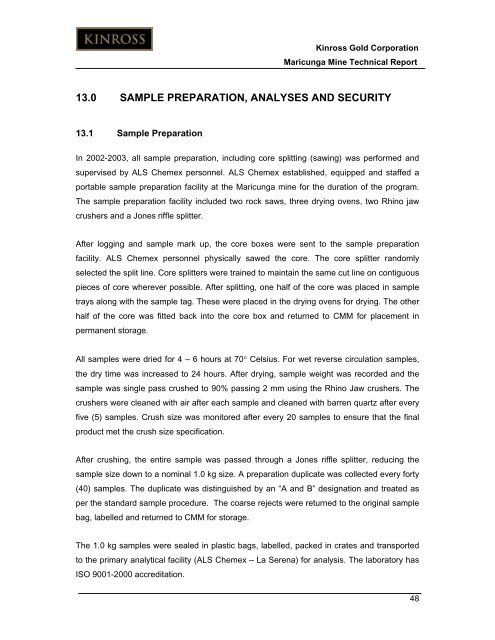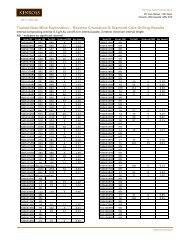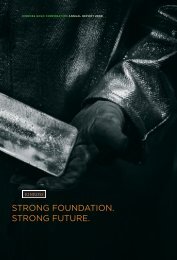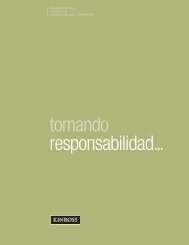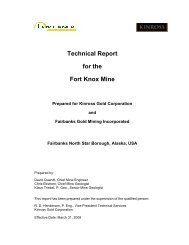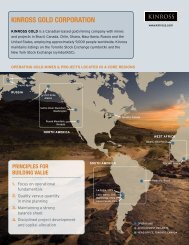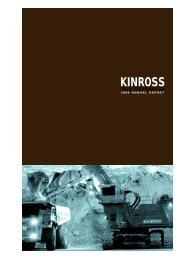Technical Report for the Maricunga Gold Mine - Kinross Gold
Technical Report for the Maricunga Gold Mine - Kinross Gold
Technical Report for the Maricunga Gold Mine - Kinross Gold
- No tags were found...
You also want an ePaper? Increase the reach of your titles
YUMPU automatically turns print PDFs into web optimized ePapers that Google loves.
<strong>Kinross</strong> <strong>Gold</strong> Corporation<strong>Maricunga</strong> <strong>Mine</strong> <strong>Technical</strong> <strong>Report</strong>13.0 SAMPLE PREPARATION, ANALYSES AND SECURITY13.1 Sample PreparationIn 2002-2003, all sample preparation, including core splitting (sawing) was per<strong>for</strong>med andsupervised by ALS Chemex personnel. ALS Chemex established, equipped and staffed aportable sample preparation facility at <strong>the</strong> <strong>Maricunga</strong> mine <strong>for</strong> <strong>the</strong> duration of <strong>the</strong> program.The sample preparation facility included two rock saws, three drying ovens, two Rhino jawcrushers and a Jones riffle splitter.After logging and sample mark up, <strong>the</strong> core boxes were sent to <strong>the</strong> sample preparationfacility. ALS Chemex personnel physically sawed <strong>the</strong> core. The core splitter randomlyselected <strong>the</strong> split line. Core splitters were trained to maintain <strong>the</strong> same cut line on contiguouspieces of core wherever possible. After splitting, one half of <strong>the</strong> core was placed in sampletrays along with <strong>the</strong> sample tag. These were placed in <strong>the</strong> drying ovens <strong>for</strong> drying. The o<strong>the</strong>rhalf of <strong>the</strong> core was fitted back into <strong>the</strong> core box and returned to CMM <strong>for</strong> placement inpermanent storage.All samples were dried <strong>for</strong> 4 – 6 hours at 70° Celsius. For wet reverse circulation samples,<strong>the</strong> dry time was increased to 24 hours. After drying, sample weight was recorded and <strong>the</strong>sample was single pass crushed to 90% passing 2 mm using <strong>the</strong> Rhino Jaw crushers. Thecrushers were cleaned with air after each sample and cleaned with barren quartz after everyfive (5) samples. Crush size was monitored after every 20 samples to ensure that <strong>the</strong> finalproduct met <strong>the</strong> crush size specification.After crushing, <strong>the</strong> entire sample was passed through a Jones riffle splitter, reducing <strong>the</strong>sample size down to a nominal 1.0 kg size. A preparation duplicate was collected every <strong>for</strong>ty(40) samples. The duplicate was distinguished by an “A and B” designation and treated asper <strong>the</strong> standard sample procedure. The coarse rejects were returned to <strong>the</strong> original samplebag, labelled and returned to CMM <strong>for</strong> storage.The 1.0 kg samples were sealed in plastic bags, labelled, packed in crates and transportedto <strong>the</strong> primary analytical facility (ALS Chemex – La Serena) <strong>for</strong> analysis. The laboratory hasISO 9001-2000 accreditation.48


